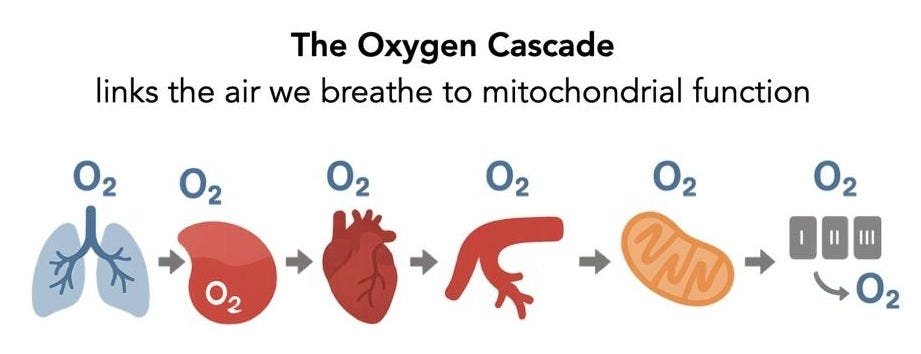Beyond Fitness: VO₂ Max as a Window Into Your Future Health
This one integrated metric tells you more about your risk of death and disease than any other.
What if one number could tell you how ready your body is to face physical stress, overcome illness, and even predict your longevity? That number exists—and it’s called VO₂max.
VO₂max is more than a fitness metric. It’s a powerful indicator of your body’s peak capacity to use oxygen—a measure of how well your heart, lungs, blood, muscles, and mitochondria work together under stress. When your body breaks down carbohydrates and fats to produce energy, oxygen is the essential fuel. The more oxygen your body can utilize at maximum effort, the better you perform, recover, and thrive.
In essence, VO₂max captures your body’s ultimate ability to create energy—and stay alive in the face of stress.
But what exactly is VO₂max? How is it measured? Why does it matter, even if you’re not an athlete?
In this 2-part series, we’ll explore the science, history, and practical value of VO₂max—and why it's one of the most important numbers in your health story.
The Science Behind VO₂max
Let’s start 2 billion years ago.
For the first time, a cell and a mitochondrial symbiont assimilated, which endowed early organisms with oxygen-dependent energy production. As mitochondria hold the necessary machinery to transfer electrons onto oxygen in the process of ATP production, this made cellular functions significantly more energy efficient. Aerobic (oxygen-dependent) energy production can yield significantly more ATP per gram of glucose, for example, than anaerobic energy production (oxygen-INdependent).

I say this to orient you to human being’s historical physiological origins. Throughout evolution, our ability to utilize oxygen has endured, and represents a fundamental function of the capacity for survival.
Over the last 2 billion years, however, our machinery has become significantly more complex. Human have organs (!), and those organs function together in an integrated and coordinated fashion. How we get oxygen from the atmosphere to our mitochondria follows the oxygen cascade.
The cascade begins as we breathe air (~20.93% of the air at sea level on Earth is oxygen) into our lungs.
Red blood cells with low oxygen content accept that oxygen in the tiny vessels in our lungs, and store that oxygen in the protein hemoglobin which lives inside the red blood cells.
Newly oxygenated red blood cells then make it back to the heart, which pumps oxygen-rich blood throughout the body.
Oxygen is delivered to all the organs and is extracted by organs in which there is energy demand to fuel ATP production in the mitochondria.
In the mitochondria, oxygen serves as the final electron acceptor in the electron transport chain, which are derived from the chemical reactions that break down fats, carbohydrates, and amino acids for fuel.
Even while resting, sleeping, etc. the body requires oxygen to generate and expend energy (that is, resting energy expenditure (REE)). However, during maximal exercise, your muscles can demand up to 80-90% of the body’s blood flow to get the oxygen it needs to support the energy demands imposed.
You can see (figure below) that oxygen-rich blood is shifted away from your other organs (e.g. kidneys, liver, GI) to maintain blood flow to the brain, and increase blood flow to your pumping heart and exercised muscles. Note also, the ability to increase blood flow to your heart and muscles can be trained, as athletes are able to get multiples of the maximal rate of blood flow to exercising organs during maximal exercise.
The body has numerous mechanisms in order to coordinate the provision of oxygenated blood to the organs with the most demand. Thus the single metric at maximal exercise, VO₂max, can serve as an integration of our system’s ability to meet the demands of maximal physiological stress.
When broken down into components (ie. lungs, heart, blood, vasculature, muscle, nervous system), we can also of course study those in isolation. There are a number of tests that lead to biomarkers that reflect the function or status of each of these systems independently.
Pulmonary function tests can be performed to understand lung mechanics, volumes, and gas exchange in relative isolation from the rest of the body.
One can study the heart in isolation with ECGs and echocardiograms (ultrasound)
Standard labs can tell you the amount of red blood cells, and the fraction of your blood comprised of red blood cells (hematocrit), and the amount of hemoglobin.
The isolation of each of these components serves a role in describing disease in modern medicine. While the coordination of all of these components into a single metric tells you how the entire system is functioning.
It turns out, this coordinated metric, rather than any single independent metric, is one of the most important biomarkers to determine your health status, and protective status against death and disease.
VO₂ Max is one of the strongest independent predictors of all-cause mortality
When studied in hundreds of thousands of people across all races, ethnicities, ages, etc., one’s VO₂max is an extremely strong predictor of risk of death from any cause. If you’re 30–49 and in the highest fitness category (top 2%), your risk of dying from any cause is only 16% of the risk faced by someone in the lowest 20% of fitness.
Even moving into the next VO₂max category (21-40th percentile) can lower your risk of death by 20-40%, depending on your age.
At any age, any improvement in VO₂max lowers your risk of death.
There any exceedingly few biomarkers that exist that show such a clear linear relationship for any person at any age that predicts your risk of death from any cause. Further, higher fitness is associated with lower risks of having diagnoses of chronic diseases or having drug prescriptions for chronic disease management.
The higher the fitness level, the lower rates of chronic diseases, biomarker abnormalities, and use of prescription medications. This graph is showing the rates of disease and medication use at an average age of 61.3 years old. The trend with smoking and increased fitness level suggests also that healthy habits (regular physical activity and lack of smoking) go hand in hand at the population level.
The trends are clear: higher fitness is associated with lower risk of death, less disease, and fewer prescriptions.
The clinical importance of measuring VO₂max annually (or other proxies of cardiorespiratory fitness) has been recommended for nearly a decade by physicians and scientists at the American Heart Association.
They in fact recommend that all adults should have their fitness measured every year as a part of their annual exam. While I never saw this while training in medical school, physicians, coaches, and trainers are increasingly offering fitness testing as many begin to truly recognize its importance. Perhaps in the coming years we will see VO₂max as a vital sign…











Really well-written. Came to know a lot about the topic. Thanks for sharing the image of the mitochondria as well. Cheers..
Thanks for this great piece, Brooks. The charts showing lower disease prevalence with higher fitness is especially compelling. At the Whoop Unlocked event, they mentioned Afib being slightly more common in older endurance athletes — are there other conditions where higher fitness might carry increased risk?